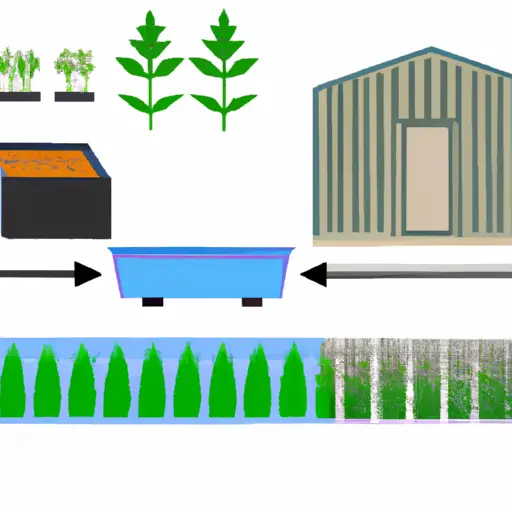Problem-Solving with Containers: Tackling Challenging Growing Conditions
Introduction:
Gardening is a popular hobby that allows individuals to connect with nature and create beautiful spaces. However, not everyone has access to the ideal growing conditions required for a successful garden. Many face challenges such as limited space, poor soil quality, or extreme weather conditions. Fortunately, containers provide an excellent solution for tackling these challenging growing conditions. In this article, we will explore how container gardening can overcome these problems and offer practical tips for successful cultivation.
1. Limited Space:
One of the primary challenges faced by urban dwellers is limited gardening space. High-rise apartments or tiny city backyards often leave little room for traditional gardens. However, the beauty of container gardening lies in its versatility and ability to thrive in small areas. Containers can be placed on balconies, window sills, rooftops, or even vertically suspended to make use of available vertical space.
Vertical gardening using containers offers endless possibilities by utilizing wall-mounted planters, hanging baskets, and stacked pots. By maximizing every inch of available space, urban gardeners can grow a wide variety of plants ranging from herbs and vegetables to flowers and shrubs.
2. Poor Soil Quality:
Another common challenge faced by gardeners is poor soil quality. Many regions have soil that lacks essential nutrients or suffers from excessive clay or sand content. In such cases, container gardening provides an excellent opportunity to bypass poor soil conditions altogether.
By using high-quality potting mix or creating custom soil blends specifically tailored for each plant’s needs, gardeners can ensure optimal growth regardless of the underlying soil quality. Container gardens also allow for easy monitoring and adjusting of pH levels and nutrient content to meet individual plant requirements.
3. Extreme Weather Conditions:
Extreme weather conditions such as scorching heatwaves or freezing winters can pose significant challenges for plants grown directly in the ground. However, container gardens offer the advantage of portability. During unfavorable weather conditions, containers can be moved to secure locations, such as indoors or under protective covers, to shield the plants from harm.
Additionally, containers help retain moisture better than open ground gardens, providing a buffer against droughts and reducing the risk of overwatering during heavy rains. It is essential to choose appropriate container materials that can withstand extreme temperatures without cracking or becoming damaged.
4. Pest and Disease Control:
Controlling pests and diseases is an ongoing battle for gardeners. However, container gardening provides an advantage by reducing the risk of infestations and diseases. By keeping plants confined to containers, gardeners can create physical barriers that deter pests from reaching their precious plants.
Furthermore, container gardening allows for better observation and early detection of any pest or disease issues that may arise. Affected plants can be easily isolated and treated promptly, preventing the spread of problems throughout the entire garden.
Practical Tips for Successful Container Gardening:
1. Size Matters:
Choose appropriately sized containers to accommodate each plant’s mature size and growth habit. Small pots restrict root development and may cause stunted growth, while oversized containers waste valuable space and retain excessive moisture.
2. Adequate Drainage:
Ensure each container has sufficient drainage holes to prevent waterlogging, which can lead to root rot. Place a layer of gravel or broken pottery at the bottom of the pot before adding potting mix to improve drainage further.
3. Right Plant Selection:
Consider the specific growing requirements of each plant, such as sunlight exposure, water needs, and temperature preferences. Select plants that are compatible with each other in terms of these requirements when grouping them together in containers.
4. Watering and Fertilizing:
Regularly monitor soil moisture levels using a moisture meter or by checking it with your finger up to knuckle depth. Avoid overwatering or underwatering by adjusting watering frequency accordingly.
Fertilize container-grown plants regularly using a balanced, slow-release formulation or a water-soluble fertilizer at half the recommended strength. Container plants have limited access to nutrients, so providing them with a nutrient boost is crucial for healthy growth.
5. Pruning and Maintenance:
Regularly prune plants to control size and promote bushier growth. Deadhead spent flowers to encourage continuous blooming and remove any yellowing or damaged leaves promptly.
Conclusion:
Container gardening offers a practical solution for overcoming challenging growing conditions. Whether it is limited space, poor soil quality, extreme weather conditions, or pest control issues, containers provide flexibility, portability, and control over various aspects of plant cultivation. By selecting appropriate containers, maintaining soil quality and moisture levels, choosing suitable plant varieties, and implementing regular maintenance practices, gardeners can successfully tackle these challenges and create thriving container gardens filled with beauty and productivity. So, don’t let challenging growing conditions hinder your gardening dreams; embrace the power of container gardening!














